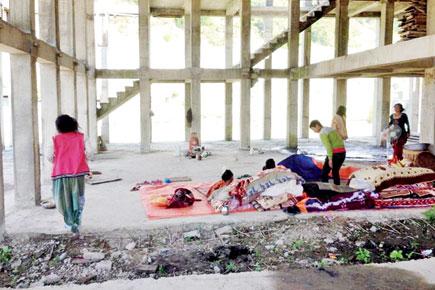Lali Gurans, which has met a roadblock in terms of funding, survived the 7.8-magnitude earthquake on April 25

In August 2013, the Lali Gurans Orphanage and public library in Gagalphedi, around 10 kilometres from Kathmandu was founded by Christopher Gish, founder of Colorado-based Seeds of Change Foundation (SOCF).
ADVERTISEMENT

Thirty victims of the Nepal earthquake have taken refuge at the Lali Gurans orghanage
The project currently is only half complete due to a severe financial crunch. Still, it miraculously survived the deadly earthquake which devasted the Himalayan kingdom. “The 7.8-magnitude earthquake that struck northwest of Kathmandu on April 25 caused enormous suffering and devastation. The orphanage’s raft foundation and its double exoskeleton frame of 300-mm reinforced concrete were designed to be resilient in this earthquake-prone region. The partially-completed LaliGurans orphanage presently provides a seismically-stable location with toilets, water and living area for 20-30 local residents who have been displaced from their homes,” says Kishor Lohani, the local
project manager.
A well built structure
In an email interview, Gish said, “The new facility utilises low-technology renewable energy and material resources, thus significantly reducing operating costs. Using local construction techniques and material, the design invests in indigenous workmanship to minimise embodied energy and maximise lifespan. Aiming to overcome the image of the orphanage as an institution, the project will address the needs of the nearby communities by offering a library accessible to the public and a seismically stable refuge area during earthquakes.”
 Once complete, the project will address the needs of the nearby communities by offering a library accessible to the public and a seismically-stable refuge area during earthquakes
Once complete, the project will address the needs of the nearby communities by offering a library accessible to the public and a seismically-stable refuge area during earthquakes
Its concrete made with fly ash avoids waste, conserves virgin materials, and reduces processing energy. Window frames, built-in furniture and freestanding elements are made from durable, locally-sourced teak.
“Thermal mass, which is a material’s resistance to change in temperature, absorbs radiation throughout the day releasing it at night. During winter, the low sun penetrates deeper, providing warmth. Operable windows allow inhabitants to control temperature and air quality. Larger spaces have cross-ventilation, and the main stairwell provides stack ventilation. Although the orphanage is well-shaded from direct sunlight by its brise-soleil and planting, its glazing allows for plentiful indirect light reducing electrical use,” explained Gish, adding that 15 175W solar panels will provide enough supply of electricity for the entire building. “Two 5m and 6m diametre solid-dome anaerobic digesters provide gas for heating, cooking and lighting. Drinking water is collected from the ground and rainwater, is passed through a UV filtration system,” said Gish.
The big picture
Once complete, organic food will be produced by the two rooftop gardens, 80 fixed drip-irrigation planters, and more than 300 vertical hanging planters, fed with bio-slurry and greywater (gently used water from bathroom sinks, showers, tubs, and washing machines). Fruit trees in the garden will complement vegetables and herbs grown in planters lining the exoskeleton, social spaces, exterior circulation, and roof garden.
In a bid to raise funds to complete the project, Gish and a team of people plan to ride bicycles from Colorado to California to raise awareness and money for the project three to four months down the road.
For more information, log on to www.lali-gurans.org and www.wehelpnepal.org
 Subscribe today by clicking the link and stay updated with the latest news!" Click here!
Subscribe today by clicking the link and stay updated with the latest news!" Click here!






